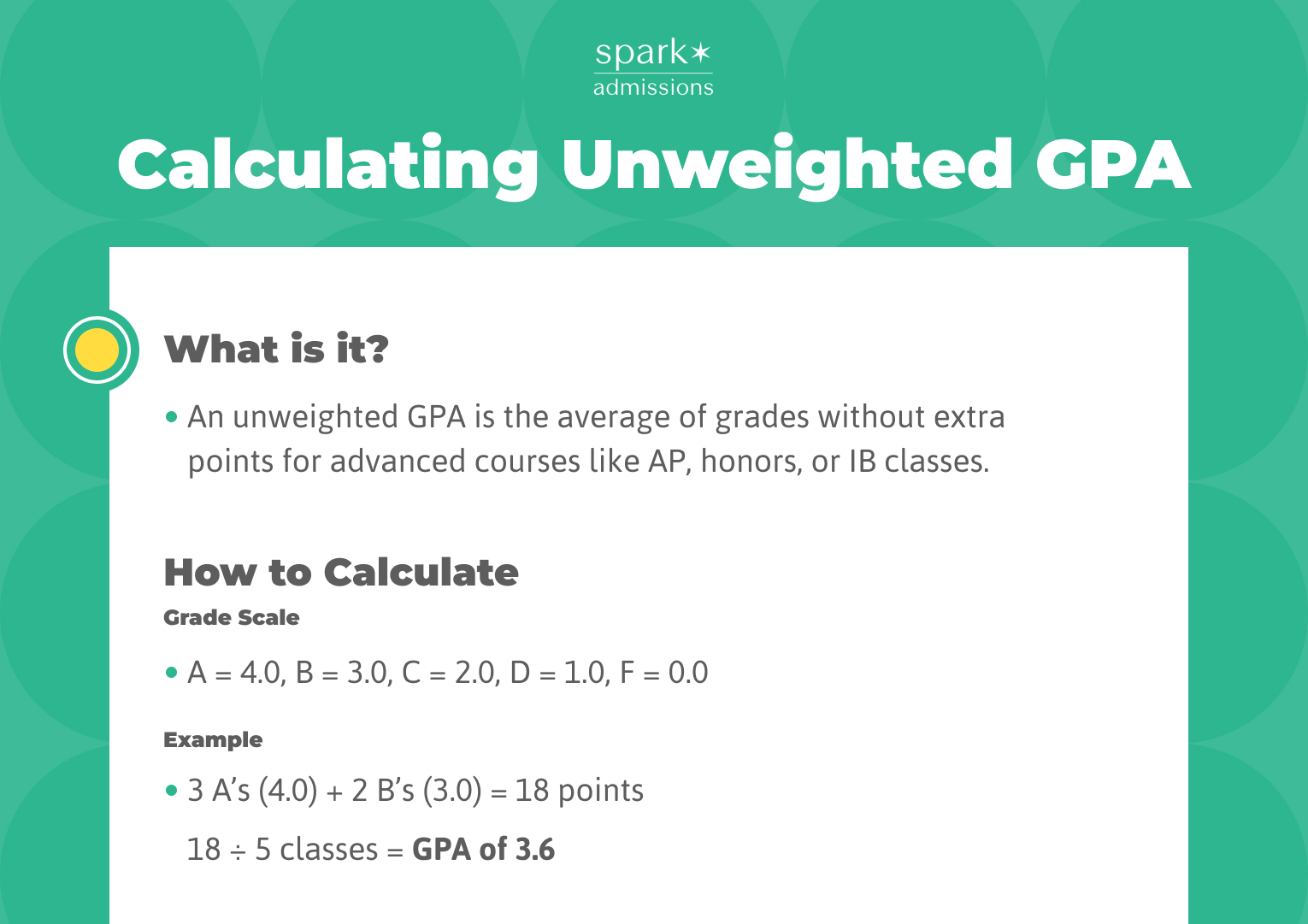- Blog
- > GPA
How to Calculate Unweighted GPA for High School Students
- Dr. Rachel Rubin
- | April 3, 2025

For high school students thinking about college applications, understanding GPA calculations is essential. Colleges evaluate grade point averages to assess academic performance, and GPAs come in two primary forms: weighted and unweighted. An unweighted GPA follows a traditional 4.0 scale, providing a straightforward way to measure grades without considering course difficulty.

Calculating Unweighted GPA
An unweighted GPA is determined by averaging the grade points earned in all classes without adding extra weight for AP courses, honors classes, or IB courses. Most colleges use the standard 4.0 scale to assess a student’s grades, with numerical values assigned as follows:
- A = 4.0
- B = 3.0
- C = 2.0
- D = 1.0
- F = 0.0
To calculate an unweighted GPA, add the total points earned from all courses and divide by the number of classes taken. For example, a student who takes five classes and earns three A’s and two B’s would calculate their GPA by adding up the grade points (4.0 + 4.0 + 4.0 + 3.0 + 3.0 = 18.0) and dividing by the total number of classes (18.0 ÷ 5 = 3.6).
This method does not account for the difficulty of a class, meaning an A in a regular history course carries the same weight as an A in AP English or an IB Mathematics course. This is where a weighted GPA comes in. If a weighted GPA is not offered by your school, some colleges recalculate GPAs to create a more standardized comparison. Using a GPA calculator or checking a specific school’s policies can help students understand how their grades will be interpreted in the admissions process.
While a high unweighted GPA is important, most colleges also consider other factors, including total credits earned, grade trends, and performance in challenging coursework. Even if a student’s grades received in an AP course are slightly lower than in a standard class, demonstrating strong academic effort can still make an impact on college applications. This is why unweighted and weighted GPA matters.
Weighted vs. Unweighted GPA
Many high schools report both weighted and unweighted GPAs. A weighted GPA system assigns additional points for honors classes, Advanced Placement classes, and International Baccalaureate courses. For example, an A in an honors class might be worth 4.5, while an A in an AP or IB course could be worth 5.0. This adjustment reflects the rigor of challenging courses.
However, unweighted GPAs treat all courses equally, offering a neutral measure of academic performance. Colleges may look at weighted or unweighted GPAs or both to gauge consistency in grades and a student’s willingness to take advanced courses.

Why Colleges Consider Unweighted GPA
Many colleges review both weighted and unweighted GPAs to gain a clearer picture of an applicant’s academic ability. Your letter grade in a standard class may be just as strong as a letter grade in an advanced course. An unweighted GPA provides a standardized measure, helping admissions officers compare students from different high schools fairly, as grading scales and weighted GPA systems can vary significantly between schools. Some high schools may award additional points for honors, AP, or IB classes, while others may not, making it difficult to assess students solely based on a weighted GPA.
By evaluating an unweighted GPA, admissions officers can see a student’s raw academic performance without adjustments for course difficulty. However, colleges also consider the rigor of a student’s coursework. An applicant with a 3.8 unweighted GPA in advanced placement classes like AP English, AP Calculus, or AP Biology will be viewed differently from a student who earned the same GPA in regular classes. Similarly, a student who takes IB courses, such as IB Mathematics or IB English Literature, demonstrates a commitment to rigorous, college-level coursework.
Beyond your weighted or unweighted GPA, colleges look at class rank, standardized test scores, extracurricular activities, and course selection.
Unweighted GPA and Academic Performance
Unweighted GPAs provide a snapshot of academic performance across all subjects. Students who want to maintain a high unweighted GPA should develop strong study habits and time management skills to perform well across all courses. While advanced courses can enhance a transcript, earning high grades in both regular and challenging courses contributes to a well-rounded academic record.
Converting Grades to an Unweighted Scale
Different schools may use grading scales with plus and minus distinctions. Some high schools assign 3.7 for an A- and 2.7 for a B-, while others stick to whole numbers. When calculating an unweighted GPA, it’s important to follow the specific school’s grading scale to ensure accuracy.
The Impact of Unweighted GPA on Scholarships
Many scholarships consider GPA as part of the eligibility criteria. Students with strong unweighted GPAs may qualify for merit-based scholarships that help reduce college tuition costs. Colleges and scholarship programs may also assess cumulative GPAs over multiple semesters to determine academic consistency.
Weighted GPA and College Admissions
A strong GPA plays a crucial role in college applications, but do not get too caught up in letter grades in high school because they are only one part of the admissions process. While a high grade point average can demonstrate academic consistency, colleges also assess the difficulty of the courses taken. Earning a good grade in a rigorous class like AP Calculus, IB Chemistry, or Honors English Literature carries more weight than a perfect score in an easier course. For example, a student who earns a B+ in AP Physics may still be viewed more favorably than a student who receives an A in a less challenging science class because the former showcases perseverance in advanced coursework.
Admissions officers also take into account the context of a student’s GPA. Many colleges recalculate GPAs based on their own grading scales to create a more standardized comparison across applicants. This process helps level the playing field, especially when students come from high schools with different weighting policies for honors, AP, and IB courses. A student with a 3.7 unweighted GPA who has consistently taken pre-calculus, advanced placement courses, or IB subjects may stand out more than a student with a 4.0 GPA who only enrolled in regular classes.
Beyond GPA, colleges consider additional academic factors, such as grade trends and the specific courses a student chooses. An upward trajectory—where a student improves from a B in Honors Algebra to an A in AP Calculus—can indicate growth and resilience. So if your GPA isn’t where you want it to be, just know that it’s not too late to demonstrate stronger academic performance—showing an upward trend can make a meaningful impact on college admissions committees. Strong performance in advanced courses also signals readiness for college-level coursework, a factor that many colleges weigh heavily during the admissions process.
The Role of GPA in Holistic Admissions
While GPA plays a key role in college admissions, it is only one part of a student’s profile. Many schools adopt a holistic admissions approach, evaluating letters of recommendation, extracurricular achievements, leadership roles, and personal statements. A strong unweighted GPA can serve as a strong foundation for a competitive college application, but well-rounded students who demonstrate passion and dedication in multiple areas often make the strongest impression on admissions committees.
Expert Guidance for College Applications
Understanding how to calculate unweighted GPA and how it compares to weighted GPA is essential for students preparing for college admissions. Whether a student has a perfect score on the 4.0 scale or a lower unweighted GPA, focusing on academic growth and challenging coursework can strengthen applications.
At Spark Admissions, we provide personalized support to help students navigate the competitive college admissions process. Our firm continues this research-based approach. We examine admissions trends and data on an ongoing basis and always know what colleges seek in their applicants. Contact us today to develop a strategy tailored to your academic goals and maximize your college opportunities.


